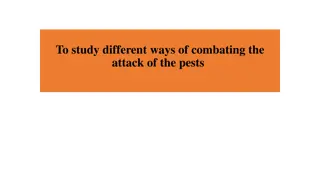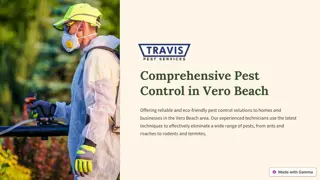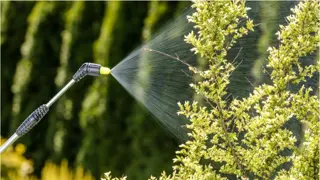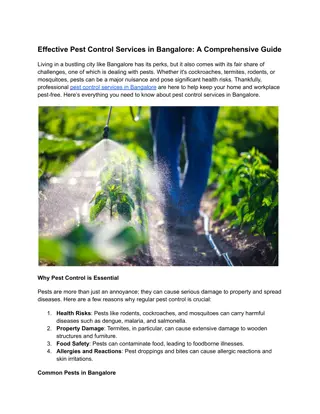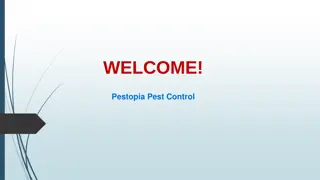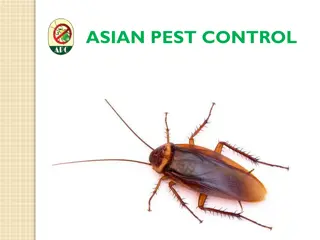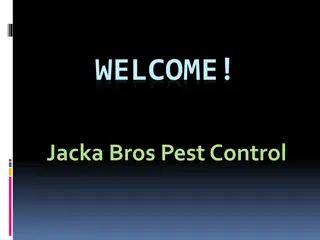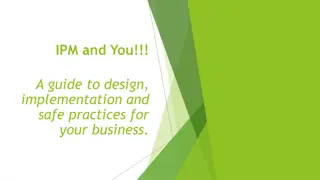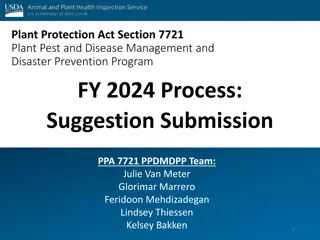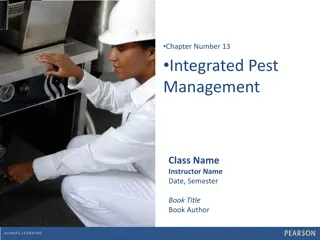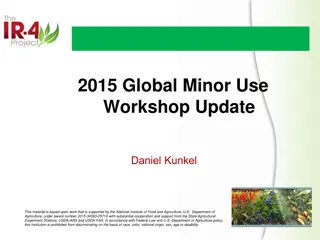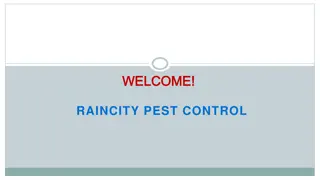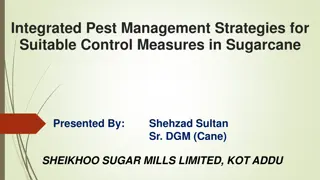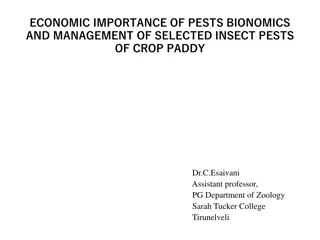Cultural Methods of Pest Control in Agriculture
Cultural methods of pest control in agriculture involve manipulating cultural practices to reduce or avoid pest damage to crops. These practices create an environment less favorable for pests or more favorable for their natural enemies, ultimately improving crop yields and minimizing pest populations. Techniques include proper preparatory cultivation, clean cultivation, systematic removal of infested parts, changes in cultivation systems, crop rotation, mixed cropping, and growing resistant varieties. Specific methods target certain pests through adjusted planting times, trap cropping, field bund trimming, flooding fields, and draining fields. These methods are cost-effective and environmentally friendly.
Download Presentation

Please find below an Image/Link to download the presentation.
The content on the website is provided AS IS for your information and personal use only. It may not be sold, licensed, or shared on other websites without obtaining consent from the author.If you encounter any issues during the download, it is possible that the publisher has removed the file from their server.
You are allowed to download the files provided on this website for personal or commercial use, subject to the condition that they are used lawfully. All files are the property of their respective owners.
The content on the website is provided AS IS for your information and personal use only. It may not be sold, licensed, or shared on other websites without obtaining consent from the author.
E N D
Presentation Transcript
I) Cultural Methods of Pest Control The manipulation of cultural practices at an appropriate time for reducing or avoiding pest damage to crops is known as cultural control. The cultural practices make the environment less favorable for the pests and or more favorable for its natural enemies. It is the cheapest of all methods. There are two categories of cultural methods, (a) Normal agricultural practices, which control certain pests: By adopting these the farmers get benefits like improvement of crop yields and The population of certain pests do not increase abnormally i) Proper preparatory cultivation: Several insects which live or hide in the soil get exposed to sun as well as predators like birds etc due to Proper preparatory cultivation. Eg.Pupae of moths, roots grubs etc. ii) Clean cultivation: Removal of weeds which act as alternate hosts. Eg. Paddy gall fly Orseolia oryzae breeds on grasses such as Panicum sp., Cynodon dactylon etc iii) Systematic cutting and removal of infested parts: Keeps down subsequent infestation. Eg. Removal of sugarcane shoots affected by borers, Cutting and removal of infested parts of brinjal attacked by Leucinodes orbonalis Pruning of dried branches of citrus eliminates scales and stem borer.
Clipping of tips of rice seedlings before transplanting eliminate the egg masses of stem borer. Clipping of leaf lets in coconut reduces the black headed caterpillar iv) Changes in the system of cultivation : Change of banana from perennial to annual crop reduced the infestation of banana rhizome weevil in addition to giving increased yields. v) Crop rotation: Crop rotation is most effective practice against pests that have narrow host range and dispersal capacity. Hence if a non-host crop is grown after a host crop,it reduces the pest population. eg: Cotton should be rotated with non hosts like ragi, maize, rice to minimize the incidence of insect pests. Groundnut with non leguminous crops is recommended for minimizing the leaf miner incidence. vi) Mixed cropping: Intended for getting some return when one crop is attacked, the other escapes. Eg. Garden peas and sunhemp vii) Growing resistant varieties: certain varieties resists pest attack . Eg: Surekha variety to gall midge, TKM -6 and Ratna for stem borer.
b) Cultural practices specially adopted for certain pests 1. Adjusting planting or sowing or harvesting times to avoid certain pests : The manipulation of planting time helps to minimize pest damage by producing asynchrony between host plants and the pest or synchronizing insect pests with their natural enemies. Eg. Early planting of paddy in kharif and late planting in rabi minimize the infestation of rice stem borer. Early sown sorghum in kharifreduces the infestation of shoot fly 2. Trap cropping: Growing of susceptible or preferred plants by important pests near a major crop to act as a trap and later it is destroyed or treated with insecticides. Trap crop may also attract natural enemies thus enhancing natural control. 3. Trimming field bunds: Grasshopper eggs, which are laid in field bunds are destroyed by trimming field bunds 4. Flooding the field: Flooding of fields is recommended for reducing the attack of cutworms, army worms, termites, root grubs etc,. Eg: For cutworms like paddy swarming caterpillar and ragi cutworm by flooding the fields caterpillars float and leave the plants
5. Draining the fields: In case of paddy case worm Nymphula depunctalis which travel from plant to plant via water. it can be eliminated by draining or drying the field. Draining the rice fields for 3-4 days during infestation controls BPH and whorl maggot. Alternate drying and wetting at 10 days interval starting from 35 DAT reduces the BPH and WBPH. 6. Alley ways: Formation of alley ways for every 2 m in rice field reduces the BPH Nilaparvata lugens. Destruction of crop residue: Stubbles of sugarcane and paddy that harbour borers should be ploughed up and burnt. 6.Deep ploughing in summer exposes most oft the soil inhabiting insects to sun and hot winds and get them killed 7.Periodical drying of stored produce against stored grain pests. 8. Pruning of dried twigs/ branches to eliminate pests like scales and orange borer
B. Mechanical Methods of Pest Control : Reduction or suppression of insect pest population by means of manual devices or labour Hand picking and collection with hand nets and killing insects: Handpicking is most ancient method which iseffective under certain conditions. Egg masses, larvae or nymphs and sluggish adults can be handpicked and destroyed. Eg. Egg masses of paddy stem borer (Scirpophaga incertulas) and groundnut hairy caterpillar - Most of the insects can be collected with hand nets and destroyed. - Collection and destruction of fallen fruits is effective against fruit flies and fruit borers. - Manual collection and destruction of pink bollworm attacked rosette flowers, withered and drooped terminals infested by spotted bollworm can reduce the incidence of these pests in cotton. Provision of preventive barriers: Digging of 30 -60 cm wide and 60 cm deep trenches or erecting 30 cm height tin sheets barriers around the fields is useful against pests like hairy caterpillars.
Bagging / wrapping of pomegranate and mango fruits in paper bags avoids the infestation of pomegranate butterfly Virachola isocrates and mango fruit fly Bactrocera dorsalis Tin bands are fixed over coconut palms to prevent damage by rats. Other mechanical methods: 1. Extraction of adult Rhinoceros beetle (Oryctes rhinoceros) from the crown of coconut trees using an arrow headed rod/hook. 2. Construction of rat proof godowns 3. Use of an alkathene band around the tree trunks of mango to check the migration of first instar nymphs of mealybugs and red ants 4. Sticky bands around tree trunks against red tree ant (Oecophylla samaragdina) 5. Systematic shaking of root grub adults harbored trees during evening hours to dislodge and destroy by dumping in fire. 6. Shaking ofredgram plantsto collect and destroy later instars of Helicoverpa armigera 7. Shaking the trees and bushes by which the insects fall to the ground and they can be collected 8. Sieving and winnowing against stored grain pests 9. Using mosquito nets fly proof cages etc.
II) Physical Methods of Pest Control: Use of certain physical forces to minimize the pests -A material called drie-die, consist of highly porous,silica gel which when applied abrades the insect cuticle thus encouraging loss of moisture resulting in death. It is mainly used against stored product pests. - Kaolinic clay after activation with acid and heat can be mixed with stored grain. The clay minerals absorb the lipoid layer of the insect cuticle by which the insects lose their body moisture and die due to desiccation. - Artificial heating and cooling of stored products will prevent insect damage. Usually high temperatures are more effective than low temp. Stored products can be exposed to 550C for 3 hours to avoid stored product pests - Steam sterilization of soil kills soil insects - Vapour Heat Treatment (VHT): Heated air is saturated with water (>RH 90%) for period of 6 to 8 hours for raising temperature to 43-44.5 C in case of mango against fruit flies. - Oxygen stress and carbon dioxide concentration: In air tight containers small volume of air is enclosed, the available oxygen is quickly utilized by insects and raise concentration of carbon dioxide. High concentration of carbon dioxide leads to death of stored products insects.
Male insects can be made sterile by exposing them to gamma radiation or by using chemicals. When sterile males are released in normal population they compete with normal males in copulation and to that extent reductive capacity of the population are reduced. Light traps are arranged for attracting the insects, which are trapped by keeping water or oil in a container or a killing bottle below the light trap. Light traps are useful for monitoring the population of important insect pests in an area. Eg: Most of the moths and beetles. - Flame thrower is a compressed air sprayer with kerosene oil for producing flames. There is a lance, which is fitted with a burner. When the burner is heated, the kerosene oil is released and it turns into flames. Used for burning locust populations, congregation of caterpillars, patches of weeds etc.
III) Legislative / Legal / Regulatory Methods of Pest Control : In early days there were no restrictions on the transport of plants and animals from one country to another since the danger involved in it is not realized, which resulted in introduction of pests form one country to another. In many countries many of the dangerous pests have frequently been found to be foreign pests and they inflict greater damage than the indigenous ones. Potato tuber moth Pthorimea operculella, cotton cushiony scale Icerya purchasi, wooly aphis on apple Eriosoma lanigerum, Quarantine: The word quarantine is derived from Latin word Quarantum which means forty (40) . Plant quarantine is defined as the legal enforcement of the measures aimed to prevent pests from spreading or to prevent them to multiply further in case they have already gained entry and have established in new restricted areas. The first Quarantine Act in USA came into operation in 1905. While Govt. of India passed an Act in 1914 entitled Destructive Insect and Pests Act of 1914 to prevent the introduction of any insect, fungus or other pests into our country. This was later supplemented by a more comprehensive act in 1917. The legislative measures in force now in different countries can be grouped into five classes. They are,
1) Legislation to prevent the introduction of foreign pests: To prevent the entry of foreign pests all countries have restrictions. They enforce quarantine laws. The imported plant material has to be thoroughly examined at the ports of entry. The importation of plant material from foreign countries has to be done only through any of these ports.The consignment should also be accompanied with the certificate issued by the Officers of agriculture department of the exporting country so as confirm that the consignments are pest free. This certificate is called as Phytosanitory certificate . Import of plants by post or air is not permitted, except by experts for scientific purpose. Import of potatoes from areas known to be infected with wart disease or golden cyst nematode is totally prohibited in to our country. 2) Legislation to prevent the spread of already established pests: The Destructive Insect and Pests Act, 1914, have empowered the states to enact such laws as are necessary to prevent the spread of dangerous insects within their jurisdiction. This act was passed to prevent the spread of pests or diseases or weeds form one part of the state to another. Cottony cushiony scale when localized in Nilgiris and Kodiakanal none of the alternate host plants were permitted to get transported from these areas.
3) Legislation to enforce the application of effective control measures to prevent the damage by established pests. Under the state pests act, the farmers were asked to remove and destroy coconut leaf lets infested with black headed caterpillar Opisina arenosella around Mangalore in 1923 and in 1927 in Krishna and Guntur districts. Later it was withdrawn as the pest was successfully controlled by biological control agents. 4) Legislation to prevent the adulteration and misbranding of the insecticides. To avoid malpractices and supply of substandard chemicals, the pesticide products are to be standardized through the Indian Standards Institute. Such products carry ISI mark and are expected to confirm the level of a.i (Active ingredient) 5) Legislation to regulate the activities of men engaged in pest control operations: They have to take certain precautionary measures to avoid pesticide poisoning and undergo regular medical checkup
BIOLOGICAL CONTROL The successful management of a pest by means of another living organism (parasitoids, predators and pathogens) that is encouraged and disseminated by man is called biological control. In such programme the natural enemies are introduced, encouraged, multiplied by artificial means and disseminated by man with his own efforts instead of leaving it to nature. Techniques in biological control: Biological control practices involve three techniques viz., Introduction, Augmentation and Conservation. 1. Introduction or classical biological control:It is the deliberate introduction and establishment of natural enemies to a new locality where they did not occur or originate naturally. When natural enemies are successfully established, it usually continues to control the pest population. 2. Augmentation: It is the rearing and releasing of natural enemies to supplement the numbers of naturally occurring natural enemies. There are two approaches to augmentation. a. Inoculative releases: Large number of individuals are released only once during the season and natural enemies are expected to reproduce and increase its population for that growing season. Hence control is expected from the progeny and subsequent generations and not from the release
b. Inundative releases: It involves mass multiplication and periodic release of natural enemies when pest populations approach damaging levels. Natural enemies are not expected to reproduce and increase innumbers. Control is achieved through the released individuals and additional releases are only made when pest populations approach damaging levels. 3. Conservation: Conservation is defined as the actions to preserve and release of natural enemies by environmental manipulations or alter production practices to protect natural enemies that are already present in an area or non use of those pest control measures that destroy natural enemies.





